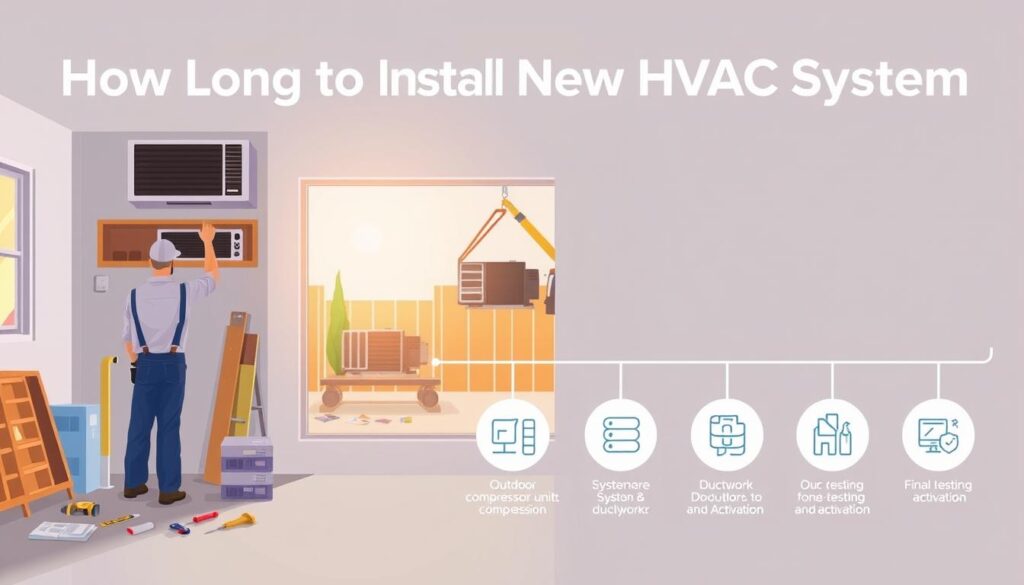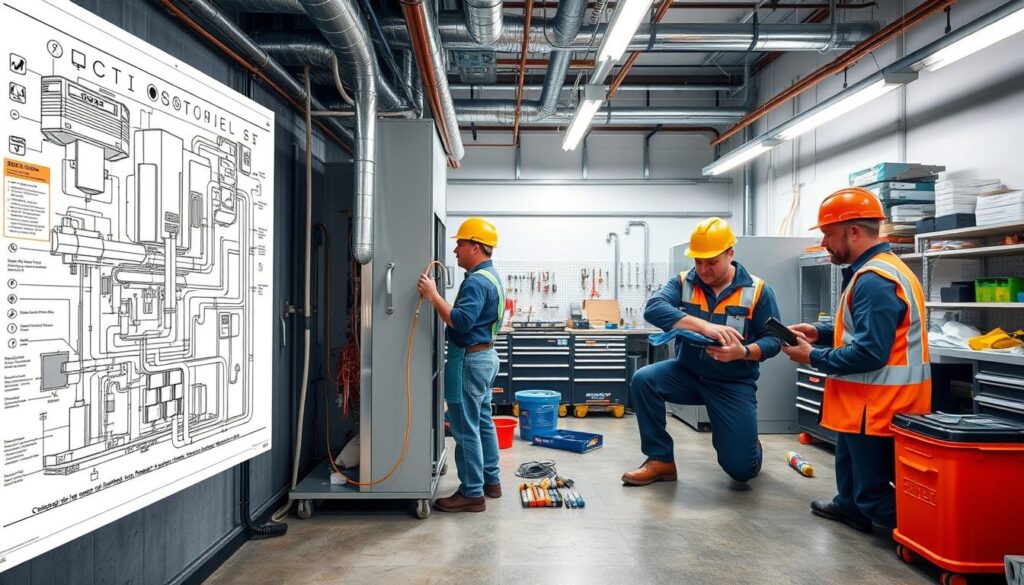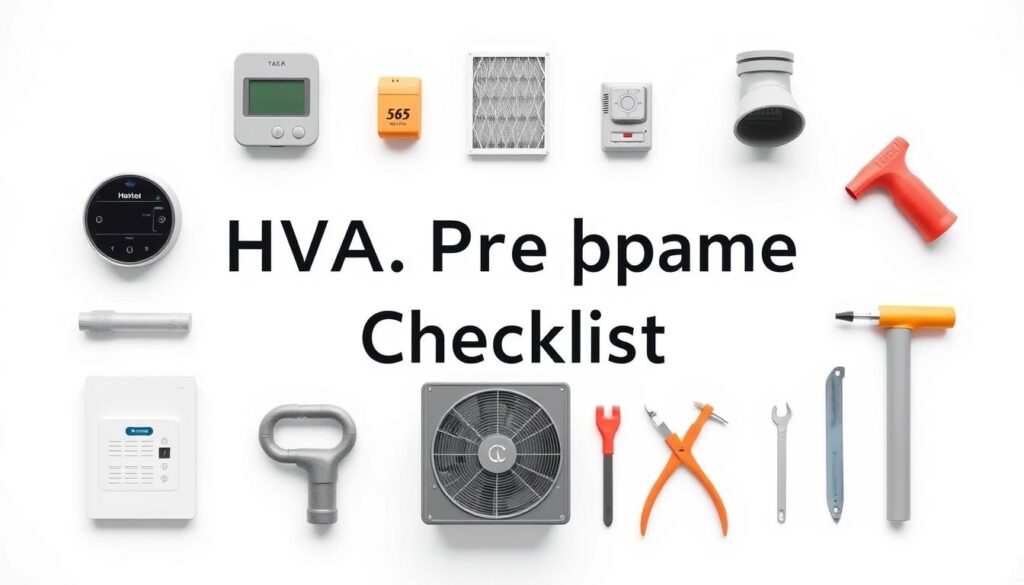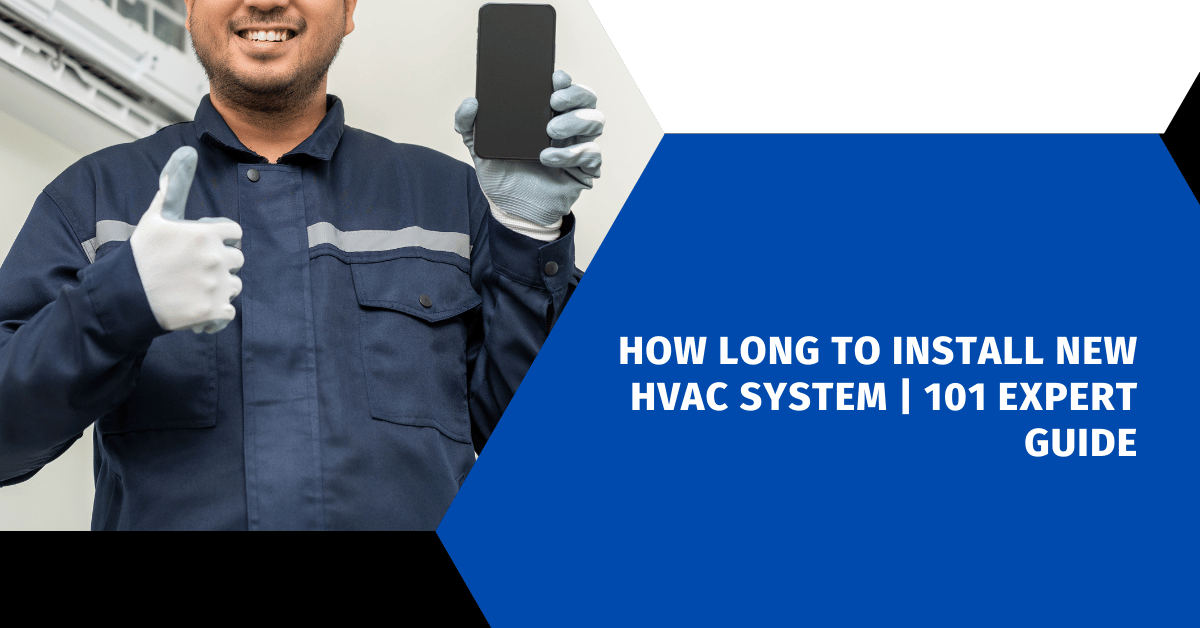Affiliate Disclosure
HVAC Guide Guys is a participant in the Amazon Services LLC Associates Program, an affiliate advertising program designed to provide a means for sites to earn advertising fees by advertising and linking to Amazon.
How Long to Install New HVAC System? Ever wondered how long it takes to make your home more comfortable with a new HVAC system? Are you ready for the journey that could change how you feel indoors?

Knowing how long to install a new HVAC system is key for homeowners planning a big change. The time it takes usually ranges from 4 to 8 hours for a typical home. But, if it’s more complex, it could take longer.
Professional HVAC technicians see each job as special. They look at your home’s needs carefully. Things like your home’s size, what’s already there, and how complex the system is can change how long it takes.
Key Takeaways
- Standard residential HVAC installation takes 4-8 hours
- Complex installations can extend to multiple days
- Home size and existing infrastructure affect installation time
- Professional technicians provide most efficient installations
- Proper planning helps minimize unexpected delays
Table of Contents
Understanding HVAC Installation Timeline Basics
When planning a new HVAC system, knowing the installation timeline is key for homeowners. The time it takes to replace your HVAC can change based on several important factors. These factors affect how long it takes to install your new AC unit.
HVAC systems are complex networks that heat, cool, and ventilate your home. Installing them in homes needs careful planning and the skills of professionals. This ensures they work at their best.
Standard Installation Duration
Most HVAC installations in homes follow a standard timeline:
- Typical central air conditioner installation: 4 to 8 hours
- Straightforward installations: Around 4 hours
- Complex installations: Up to 8-10 hours
Types of HVAC Installations
There are different types of HVAC systems that need unique installation methods:
- Changeout: Replacing parts of the existing system
- Full replacement: A complete overhaul of the system
- Zoned system installations
- Ductless mini-split systems
Professional vs DIY Installation
While DIY might seem appealing, hiring a pro is better. Certified technicians ensure the system is the right size, works efficiently, and meets local codes. They can finish the job faster and safer.
Professional installation reduces the risk of future performance issues and possible system damage.
The time it takes to replace your HVAC depends on your home’s size, current setup, and the system you choose.
Explore Our HVAC Shop
Looking for top-rated HVAC tools, parts, and accessories? Visit our shop and find the perfect solution for your needs.
Visit the ShopAverage Installation Times for Different HVAC Systems
When planning to replace your HVAC system, knowing how long it takes is key. The time needed for installation changes based on the system type you pick.
The time it takes to install your HVAC system can vary a lot. Let’s look at the average times for different cooling systems.
Central Air Conditioning Systems
Central air conditioning setups are usually the most complicated. They often need:
- 4 to 8 hours of total installation time
- Checking and possibly changing the ductwork
- Connecting to the electrical system
- Placing and calibrating the unit
Ductless Mini-Split Systems
Ductless mini-split systems are easier to install. They have:
- 4 to 9 hours for full installation
- Less invasive work
- Flexible mounting options
- Setup is faster than central systems
Window Units and Portable Systems
For fast cooling, window and portable units are great. They have:
- 2 to 4 hours for installation
- Little need for professional help
- Can be set up easily by yourself
- No need for complex ductwork or electrical changes
Tip: Always get professional HVAC technicians for the right installation and best system performance.
How Long to Install New HVAC System: Key Timeframes
Knowing how long it takes to install a new HVAC system is key for homeowners. The time needed can vary a lot. Most home installations take between 1 to 5 days.
The time it takes to set up a new HVAC system can be anywhere from a few hours to a week. Here’s what you can expect:
- Simple replacements: 4-8 hours
- Standard central air system: 1-2 days
- Complex installations: 3-6 days
- Geothermal systems: Up to a week
Several things can affect how long it takes to install:
| Installation Type | Estimated Duration | Key Considerations |
|---|---|---|
| Central Air Replacement | 4-8 hours | Good existing ductwork |
| Mini-Split System | 2-4 hours per unit | Number of indoor units |
| Complete System Overhaul | 3-6 days | Ductwork modifications |
Pro tip: Talk to your HVAC expert early to get a clear idea of the time needed for your home and system.
Explore Our HVAC Shop
Looking for top-rated HVAC tools, parts, and accessories? Visit our shop and find the perfect solution for your needs.
Visit the ShopFactors Affecting Installation Duration
Knowing how long it takes to install a new heating and cooling system involves understanding several key factors. Each HVAC installation is different. Many things can affect how long it takes to complete.

The time it takes to install your HVAC system can change a lot. This is because of a few important things:
- Home size and architectural complexity
- Current infrastructure condition
- Specific system features and technology
- Accessibility of installation spaces
Home Size and Layout Impact
The size of your home affects how long it takes to install your HVAC. Larger homes need more ductwork and complex designs, which can make the job longer. Smaller homes usually get installed faster.
Existing Infrastructure Condition
The condition of your current HVAC system is very important. If your system is in good shape, it can be replaced quickly. But, if you need to fix ducts or upgrade electrical, it will take longer.
System Complexity and Features
Systems with advanced features, like smart home integration, take longer to install. Units like geothermal or multi-zone mini-splits need extra time and skill.
Professional HVAC technicians say it can take 1-5 days to install a system, depending on your needs.
Your installation time will depend on these factors. So, every HVAC upgrade is a custom job for your home.
Pre-Installation Requirements and Planning
Getting ready for a new HVAC system needs careful planning. This ensures the installation goes smoothly and quickly. Knowing what to do before the install can make a big difference.
Before the installation day, several important steps must be taken:
- Conduct a thorough site inspection
- Perform precise load calculations
- Obtain necessary local permits
- Verify home accessibility
- Prepare installation spaces
Your HVAC contractor will handle the tough pre-installation tasks. They’ll check your home’s heating and cooling needs. This ensures the right system is picked. About 75% of U.S. homes use HVAC systems, so planning is key for good performance.
Important preparation steps include:
- Clear access paths for technicians
- Protect flooring and furniture
- Ensure electrical systems are ready
- Verify outdoor unit placement space
- Prepare for possible temporary home disruption
Professional contractors suggest turning off power sources about 10 minutes before they arrive. They also need easy access to circuit breakers and work areas. By doing these steps, you can avoid delays and make the installation go smoothly.
Proper planning can reduce installation complications and ensure your new HVAC system operates at peak efficiency from day one.
Explore Our HVAC Shop
Looking for top-rated HVAC tools, parts, and accessories? Visit our shop and find the perfect solution for your needs.
Visit the ShopStep-by-Step Installation Process Overview
Knowing the timeline for installing a new AC unit helps homeowners plan for the HVAC replacement. Professional technicians have a detailed process to ensure the system is installed efficiently and safely.
Removing the Existing HVAC System
The first step in replacing your HVAC is carefully taking out the old unit. Technicians will:
- Recover refrigerant using EPA-certified recovery equipment
- Disconnect electrical connections
- Detach mounting brackets and support structures
- Remove the existing indoor and outdoor units
New System Installation Procedure
Installing your new HVAC system needs precision and skill. The steps include:
- Prepare the installation site
- Position the new indoor and outdoor units
- Connect refrigerant line sets
- Install new copper piping
- Secure electrical connections
System Testing and Calibration
After installing, technicians test the system to make sure it works well. This step involves:
- Checking refrigerant charge
- Verifying electrical connections
- Running system diagnostics
- Calibrating thermostat settings
| Installation Stage | Estimated Duration |
|---|---|
| Old System Removal | 1-2 hours |
| New System Installation | 3-5 hours |
| Testing and Calibration | 30-60 minutes |
Professional installation makes sure your new HVAC system works at its best. This can save you thousands in energy costs over 15-20 years.
Commercial vs Residential Installation Timelines
How long it takes to replace an HVAC system changes a lot between commercial and home settings. Commercial HVAC setups are much more complex and take longer than home installations.
Commercial HVAC jobs need more planning and work. Home systems can be done in 4-8 hours. But, commercial projects can take days to a week.
- Commercial installations involve larger, more complex systems
- Rooftop unit placements often require specialized equipment like cranes
- Multiple system components increase overall installation complexity
The size of the job affects the time needed. Home HVAC systems are usually 1.5 to 5 tons. Commercial systems start at 2 tons and can go up to 30 tons for big places like hospitals.
| Installation Type | Average Duration | Complexity |
|---|---|---|
| Residential HVAC | 4-8 hours | Low |
| Commercial HVAC | 1-7 days | High |
Factors influencing commercial installation timelines include building size, system type, and possible business disruptions. Experts must plan carefully to avoid disrupting business.
The key is understanding that commercial HVAC installations are not just larger versions of residential systems, but entirely different engineering challenges.
Your specific HVAC system installation process will depend on many variables. So, it’s important to talk to professional technicians who can look at your unique needs.
Explore Our HVAC Shop
Looking for top-rated HVAC tools, parts, and accessories? Visit our shop and find the perfect solution for your needs.
Visit the ShopPreparing Your Home for HVAC Installation
Getting ready for an HVAC installation project needs careful planning. When homeowners prepare their home, the installation goes smoother. This preparation makes the process safer and more efficient.

Before the installation team comes, you should do a few things. This will help make your home ready for the new HVAC system:
- Clear all installation areas, including attics, basements, and outdoor spaces
- Remove furniture and obstacles near HVAC access points
- Ensure clear pathways for technicians to move equipment
- Protect valuable items from dust or debris
Access and Safety Considerations
Your installation team needs easy access to important areas. Create a safe environment by securing pets and children during the installation process. Make sure there’s a safe space for them away from the work area.
Communication is Key
Talking well with your HVAC pros is very important. Share any concerns, ask questions, and confirm the setup time. Most installations take a full day, from start to finish.
Pro Tip: Have a designated decision-maker present during installation to address any immediate questions or concerns that may arise.
By preparing well, you’ll make the HVAC installation smooth and efficient. This way, you’ll avoid disruptions and get the most out of your new system.
Common Installation Delays and How to Avoid Them
When you plan to upgrade your HVAC, knowing about possible delays can help. Several things can slow down the installation, making it take longer than you thought.
Common problems come from different areas:
- Electrical system complications
- Unexpected ductwork modifications
- Weather-related interruptions
- Equipment availability issues
Electrical issues are a big cause of delays. If your home lacks the right electrical setup, you might need changes before starting. Checking your electrical system early can avoid surprises.
Weather can also affect when you can get your HVAC installed. Bad weather might make technicians reschedule, adding to your wait time.
| Potential Delay | Estimated Impact | Prevention Strategy |
|---|---|---|
| Electrical Issues | 1-2 Days | Pre-installation electrical assessment |
| Ductwork Problems | Up to 1 Day | Comprehensive system inspection |
| Weather Disruptions | 1-3 Days | Flexible scheduling |
To avoid delays, consider these tips:
- Choose a time when the weather is not extreme
- Get a full check of your home before starting
- Work with skilled HVAC experts
- Be flexible with your schedule
Picking a trusted HVAC contractor who expects problems can help avoid many issues. This ensures your upgrade goes smoothly and quickly.
Conclusion
Figuring out how long to install a new HVAC system can seem daunting. But, with the right information, you can handle it easily. The time it takes depends on your home’s layout, the system’s complexity, and what’s already there.
Experts usually finish installing HVAC systems in homes in 4 to 8 hours. Getting ready and picking the right system is key. Today’s HVAC systems are more efficient, saving you money in the long run.
Think about how long your new system will last, which is 15 to 20 years with care. New systems with advanced features and eco-friendly coolants work better and are kinder to the planet.
It’s smart to talk to certified HVAC pros for advice that fits your home. By doing your homework and choosing skilled installers, you’ll get a system that’s both comfortable and energy-smart.

